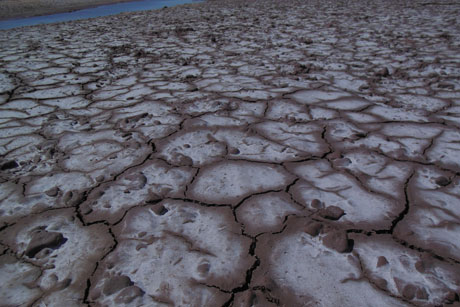At once-verdant delta, prologue of ecological tale begins
By Blaine Friedlander


Where once the Colorado River flowed with 5 trillion gallons of water into its verdant delta at the Gulf of California, that gush has trickled to zero.
Days prior to the March 23 inaugural river pulse flow – a scheduled water release to help revive the parched delta – researchers from Cornell and its affiliated Paleontological Research Institution (PRI) gathered baseline samples to understand the delta’s ecological profile.
Greg Dietl, adjunct assistant professor of earth and atmospheric sciences, led a team, including Cornell graduate students Jansen Smith and Stephen Durham, to the delta, where they traipsed through the muddy tidal flats to collect live and dead specimens of clams and snails.
“Our ecological baselines have the potential to help policy makers make informed decisions on whether the experimental pulse flows are enough to make a difference, or if it will take more water,” said Dietl, who is also the director of collections at PRI. “Efforts like ours will also help tell what’s possible in our efforts to restore the Colorado River’s delta, if society is willing to pay the cost.”
At its delta, the Colorado River endures environmental devastation thanks to a series of dams, all constructed upriver in the last century, that divert its waters throughout the Southwest and southern California. In recent years, the river’s water has ceased to flow into the Gulf of California, drastically altering the delta’s ecosystem. In a 2012 agreement – called Minute 319 – between the United States and Mexico, pulse flows of Colorado River water were approved for a five-year trial period to recreate historical spring flood conditions and to revive the parched delta.
In the course of their field work, Dietl and the students rode wavy, rough waters on fiberglass fishing boats, called “pangas,” and then waded and waddled through heavy mud to collect the molluscan samples. “To get a sufficient number of specimens to conduct statistically meaningful analyses, we had to gently push the muddy mixture through sieves and wash it in puddles of standing water left by the receding tide,” said Smith.
The researchers will use these samples to compare the abundance of snails and clams currently living in the impoverished delta to the accumulation of dead shells. These shells, buried in the top few centimeters of mud, are a record of what the delta community looked like prior to when the dams went up on the Colorado River. The researchers expect that, if these flows are successful, the living community will return to a pre-dam condition.
The National Science Foundation provided funding for this research, and the scientists will return to the delta in subsequent years to note ecological changes.
Media Contact
Get Cornell news delivered right to your inbox.
Subscribe